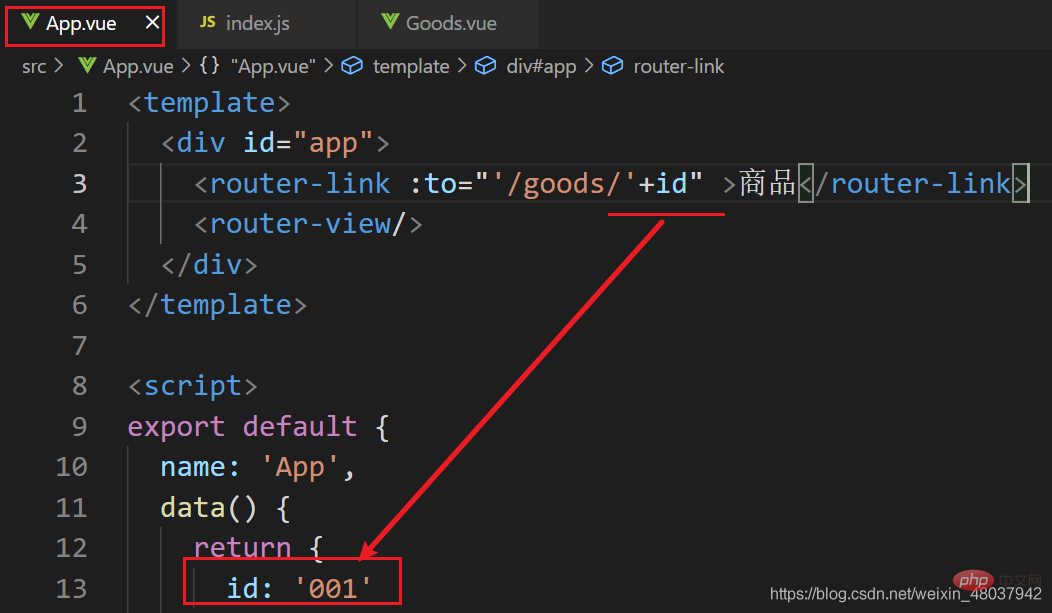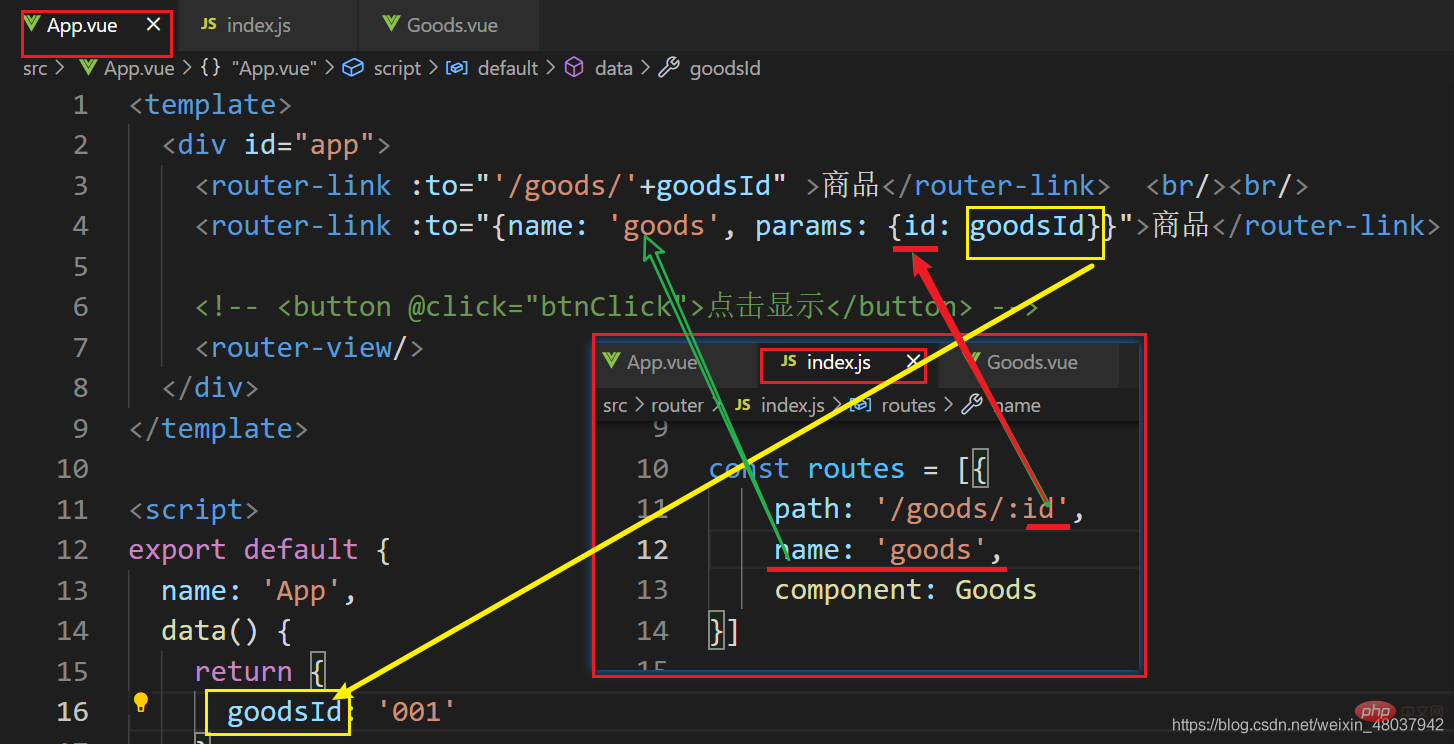What does vue dynamic routing mean?
In vue, dynamic routing is to map routes matching a certain pattern to the same component. The essence of dynamic routing is to pass parameters through url; it can be done through "params" and "query" way to pass dynamic parameters.

The operating environment of this article: Windows 10 system, Vue version 2.9.6, DELL G3 computer.
What does vue dynamic routing mean
Understanding of dynamic routing
Dynamic routing is to map routes matching a certain pattern to the same component In fact, the essence is to pass parameters through url
For example: there is a component of Goods, and we need to map different product IDs to this component. At this time, dynamic routing is needed.
Configuration of dynamic routing
You can pass dynamic parameters in two ways:
(1), params
(2), query
Note: The following code demonstrations are all in history routing mode
Parameter passing in params mode
How to configure routing: use colon: bind dynamic parameters.
//index.js中配置路由信息
const routes = [{
path: '/goods/:id',
component: Goods}]
When routing jumps, it is divided into:
(1) Use the router-link method to implement route jump
In this method, you can use a string, after the path Directly follow the corresponding value, such as: 
Second, you can use the object method, such as: 
Note:
- params method , the way the to attribute uses objects, the route must be introduced by the name attribute, and path cannot be used.
- When passing parameters in the params method, the attribute name must be consistent with the dynamic parameter name when configuring routing, otherwise an error will be reported.
(2) Use the $router method to jump to the route
//方法1
this.$router.push('/goods/' + this.goodsId)
//方法2
this.$router.push({
name: 'goods',
params: {
id: this.goodsId }})
Parameters are passed in the params method. The corresponding url address after the parameters are passed is as follows: 
How to get parameters:
$router.params. For example, if you want to get the value of id in this example, the corresponding code is:
$route.params.id
Parameter passing in query mode
Configuration When routing, normal configuration is enough, that is, how you configured routing originally, you still configure it now. For example:
const routes = [{
path: '/goods',
name: 'goods',
component: Goods}]
When routing jumps, it is divided into:
(1) Use the router-link method to implement route jump
The query parameters can only be passed through objects, and strings cannot be used.
<router-link>商品</router-link>
(2) Use the $router method to jump to the route
this.$router.push({
path: '/goods',
query: {
id: this.goodsId }
})
this.$router.push({
path: '/goods',
query: {
id: this.goodsId }
})
The parameter is passed in the query method, and the corresponding url address after the parameter is passed is displayed as: 
Note: When passing parameters in query mode, the attribute name (such as id in this example) in the query object can be named arbitrarily, unlike when passing parameters in params mode, it is restricted.
At the same time, routes can be introduced in this way using either the path attribute or the name attribute.
How to get parameters:
$route.query, if you want to get the id value in this example, the code is:
$route.query.id
In short, be sure to pay attention to:
(1), Only name can be used to introduce routes in params mode, and name and path can be used to introduce routes in query mode.
(2). Use "router" for routing jumps; use "route" to obtain parameters
[Related recommendations: "vue.js Tutorial"]
The above is the detailed content of What does vue dynamic routing mean?. For more information, please follow other related articles on the PHP Chinese website!

Hot AI Tools

Undress AI Tool
Undress images for free

Undresser.AI Undress
AI-powered app for creating realistic nude photos

AI Clothes Remover
Online AI tool for removing clothes from photos.

Clothoff.io
AI clothes remover

Video Face Swap
Swap faces in any video effortlessly with our completely free AI face swap tool!

Hot Article

Hot Tools

Notepad++7.3.1
Easy-to-use and free code editor

SublimeText3 Chinese version
Chinese version, very easy to use

Zend Studio 13.0.1
Powerful PHP integrated development environment

Dreamweaver CS6
Visual web development tools

SublimeText3 Mac version
God-level code editing software (SublimeText3)
 How to develop a complete Python Web application?
May 23, 2025 pm 10:39 PM
How to develop a complete Python Web application?
May 23, 2025 pm 10:39 PM
To develop a complete Python Web application, follow these steps: 1. Choose the appropriate framework, such as Django or Flask. 2. Integrate databases and use ORMs such as SQLAlchemy. 3. Design the front-end and use Vue or React. 4. Perform the test, use pytest or unittest. 5. Deploy applications, use Docker and platforms such as Heroku or AWS. Through these steps, powerful and efficient web applications can be built.
 How to work and configuration of front-end routing (Vue Router, React Router)?
May 20, 2025 pm 07:18 PM
How to work and configuration of front-end routing (Vue Router, React Router)?
May 20, 2025 pm 07:18 PM
The core of the front-end routing system is to map URLs to components. VueRouter and ReactRouter realize refresh-free page switching by listening for URL changes and loading corresponding components. The configuration methods include: 1. Nested routing, allowing the nested child components in the parent component; 2. Dynamic routing, loading different components according to URL parameters; 3. Route guard, performing logic such as permission checks before and after route switching.
 What is the significance of Vue's reactivity transform (experimental, then removed) and its goals?
Jun 20, 2025 am 01:01 AM
What is the significance of Vue's reactivity transform (experimental, then removed) and its goals?
Jun 20, 2025 am 01:01 AM
ReactivitytransforminVue3aimedtosimplifyhandlingreactivedatabyautomaticallytrackingandmanagingreactivitywithoutrequiringmanualref()or.valueusage.Itsoughttoreduceboilerplateandimprovecodereadabilitybytreatingvariableslikeletandconstasautomaticallyreac
 What are the core differences between Vue.js and React in componentized development?
May 21, 2025 pm 08:39 PM
What are the core differences between Vue.js and React in componentized development?
May 21, 2025 pm 08:39 PM
The core differences between Vue.js and React in component development are: 1) Vue.js uses template syntax and option API, while React uses JSX and functional components; 2) Vue.js uses responsive systems, React uses immutable data and virtual DOM; 3) Vue.js provides multiple life cycle hooks, while React uses more useEffect hooks.
 How can internationalization (i18n) and localization (l10n) be implemented in a Vue application?
Jun 20, 2025 am 01:00 AM
How can internationalization (i18n) and localization (l10n) be implemented in a Vue application?
Jun 20, 2025 am 01:00 AM
InternationalizationandlocalizationinVueappsareprimarilyhandledusingtheVueI18nplugin.1.Installvue-i18nvianpmoryarn.2.CreatelocaleJSONfiles(e.g.,en.json,es.json)fortranslationmessages.3.Setupthei18ninstanceinmain.jswithlocaleconfigurationandmessagefil
 Vue responsive principle and solution to not trigger view updates when array updates?
May 20, 2025 pm 06:54 PM
Vue responsive principle and solution to not trigger view updates when array updates?
May 20, 2025 pm 06:54 PM
When Vue.js handles array updates, the view is not updated because Object.defineProperty cannot directly listen to array changes. Solutions include: 1. Use the Vue.set method to modify the array index; 2. Reassign the entire array; 3. Use the rewritten mutation method of Vue to operate the array.
 What are the benefits of using key attributes (:key) with v-for directives in Vue?
Jun 08, 2025 am 12:14 AM
What are the benefits of using key attributes (:key) with v-for directives in Vue?
Jun 08, 2025 am 12:14 AM
Usingthe:keyattributewithv-forinVueisessentialforperformanceandcorrectbehavior.First,ithelpsVuetrackeachelementefficientlybyenablingthevirtualDOMdiffingalgorithmtoidentifyandupdateonlywhat’snecessary.Second,itpreservescomponentstateinsideloops,ensuri
 How can you optimize the re-rendering of large lists or complex components in Vue?
Jun 07, 2025 am 12:14 AM
How can you optimize the re-rendering of large lists or complex components in Vue?
Jun 07, 2025 am 12:14 AM
Methods to optimize the performance of large lists and complex components in Vue include: 1. Use the v-once directive to process static content to reduce unnecessary updates; 2. implement virtual scrolling and render only the content of the visual area, such as using the vue-virtual-scroller library; 3. Cache components through keep-alive or v-once to avoid duplicate mounts; 4. Use computed properties and listeners to optimize responsive logic to reduce the re-rendering range; 5. Follow best practices, such as using unique keys in v-for, avoiding inline functions in templates, and using performance analysis tools to locate bottlenecks. These strategies can effectively improve application fluency.







